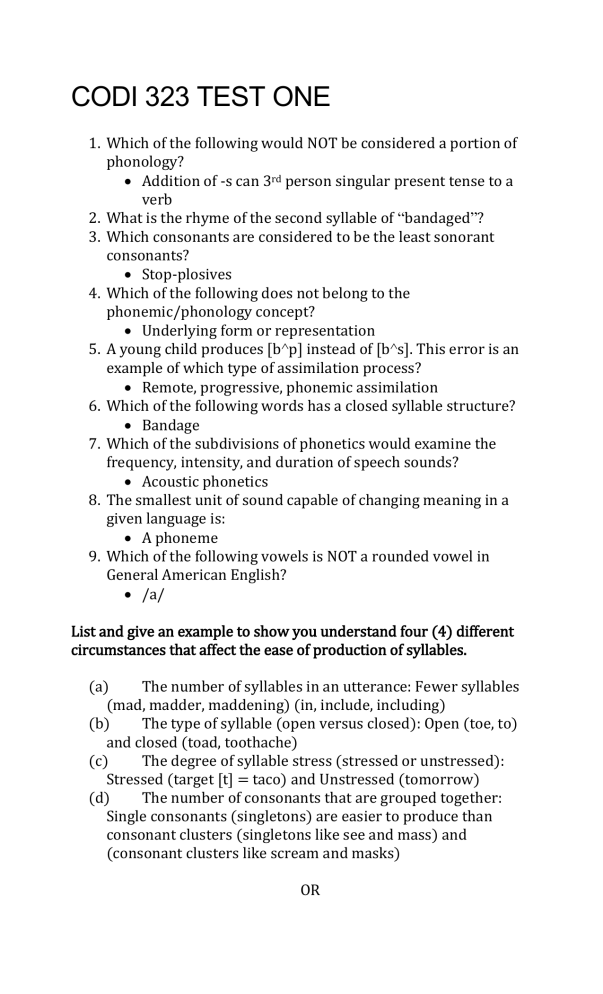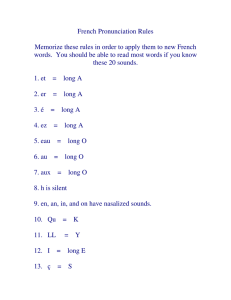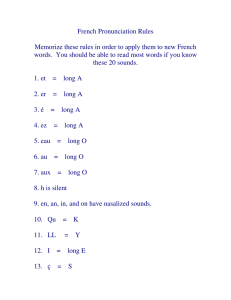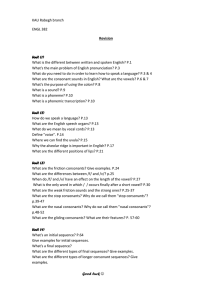
CODI 323 TEST ONE 1. Which of the following would NOT be considered a portion of phonology? Addition of -s can 3rd person singular present tense to a verb 2. What is the rhyme of the second syllable of “bandaged”? 3. Which consonants are considered to be the least sonorant consonants? Stop-plosives 4. Which of the following does not belong to the phonemic/phonology concept? Underlying form or representation 5. A young child produces [b^p] instead of [b^s]. This error is an example of which type of assimilation process? Remote, progressive, phonemic assimilation 6. Which of the following words has a closed syllable structure? Bandage 7. Which of the subdivisions of phonetics would examine the frequency, intensity, and duration of speech sounds? Acoustic phonetics 8. The smallest unit of sound capable of changing meaning in a given language is: A phoneme 9. Which of the following vowels is NOT a rounded vowel in General American English? /a/ List and give an example to show you understand four (4) different circumstances that affect the ease of production of syllables. (a) The number of syllables in an utterance: Fewer syllables (mad, madder, maddening) (in, include, including) (b) The type of syllable (open versus closed): Open (toe, to) and closed (toad, toothache) (c) The degree of syllable stress (stressed or unstressed): Stressed (target [t] = taco) and Unstressed (tomorrow) (d) The number of consonants that are grouped together: Single consonants (singletons) are easier to produce than consonant clusters (singletons like see and mass) and (consonant clusters like scream and masks) OR (a) Regressive Assimilation: When a sound segment influences a preceding sound segment (mud – [d^d] (b) Progressive Assimilation: When a sound segment influences a following sound (telephone – [tdefon] (c) Coalescence: The merging of two sounds to produce easier production (sandwich – [sæmIt] Jason has an [s] problem and is beginning to work on two-syllable words. (a) Make up a list of 6 words that progress from easy to difficult on the basis of a combination of any two of the factors you listed above. (b) State which factors you used, and explain why your easy words are easy, the medium words are medium difficult and the difficult words are actually most difficult to articulate. Write each word orthographically first, then in IPA phonetics, as you would say it. Least Difficult 1. Soapy – All front consonants that are typically easier to produce than back consonants. Being that fronting is a common problem in kids. 2. Stupid - All front consonants that are typically easier to produce than back consonants. Being that fronting is a common problem in kids. Medium Difficult 3. Stopping It’s a mix of words produced from the front and back of the mouth. So we will see if he fronts the back consonants. 4. Stagger Most Difficult 5. Sinking I feel that /r/ would be replaced by /w/ and the /e/ or schwa would be difficult to produce. Not to mention the glottal sounds also thrown in too. The word sinking has back produced consonants in both syllables. 6. Stronger Give one example of each of the following obstruent Voiced interdental fricative Singleton consonant Low back vowel /p/ Bilabial glide /a/ Voiced post alveolar affricate /w/ Velar nasal Voiceless stop alveolar fricative /t/ // Tense Sonorant front consonant vowel /i/ /n/ Define any 6 of the following terms (note there are two more terms on the next page) (a) Minimal Pair Words: Two words that have similar structures varying by one sound (dog, fog) (b) Persistent Speech Sound Disorders: Such as backing. When a child’s disorder goes on longer than it should (c) Phonetic Variations: The different ways certain sounds can be pronounced (d) Speech Sound Delay: When a child is continuing to delay speech sounds past the age where it should have fixed itself (e) Allophone: Variations in phoneme realizations that do not change the meaning of a word when they are produced in various contexts (f) Coarticulation: Concept that the articulators are continually moving into position for other segments over a stretch of speech (g) Assimilation: Adaptive articulatory change by which one speech sound becomes similar, sometimes identical, to a neighboring sound segment In row 2 transcribe each word into IPA phonetic notation as you would say the word. In row 3 use the conventional notation (CV, VCV, etc.) to fully and accurately describe the following words. Write your answers neatly and clearly please. Row 1 Row 2 Row 3 brought she eggs roughened language






